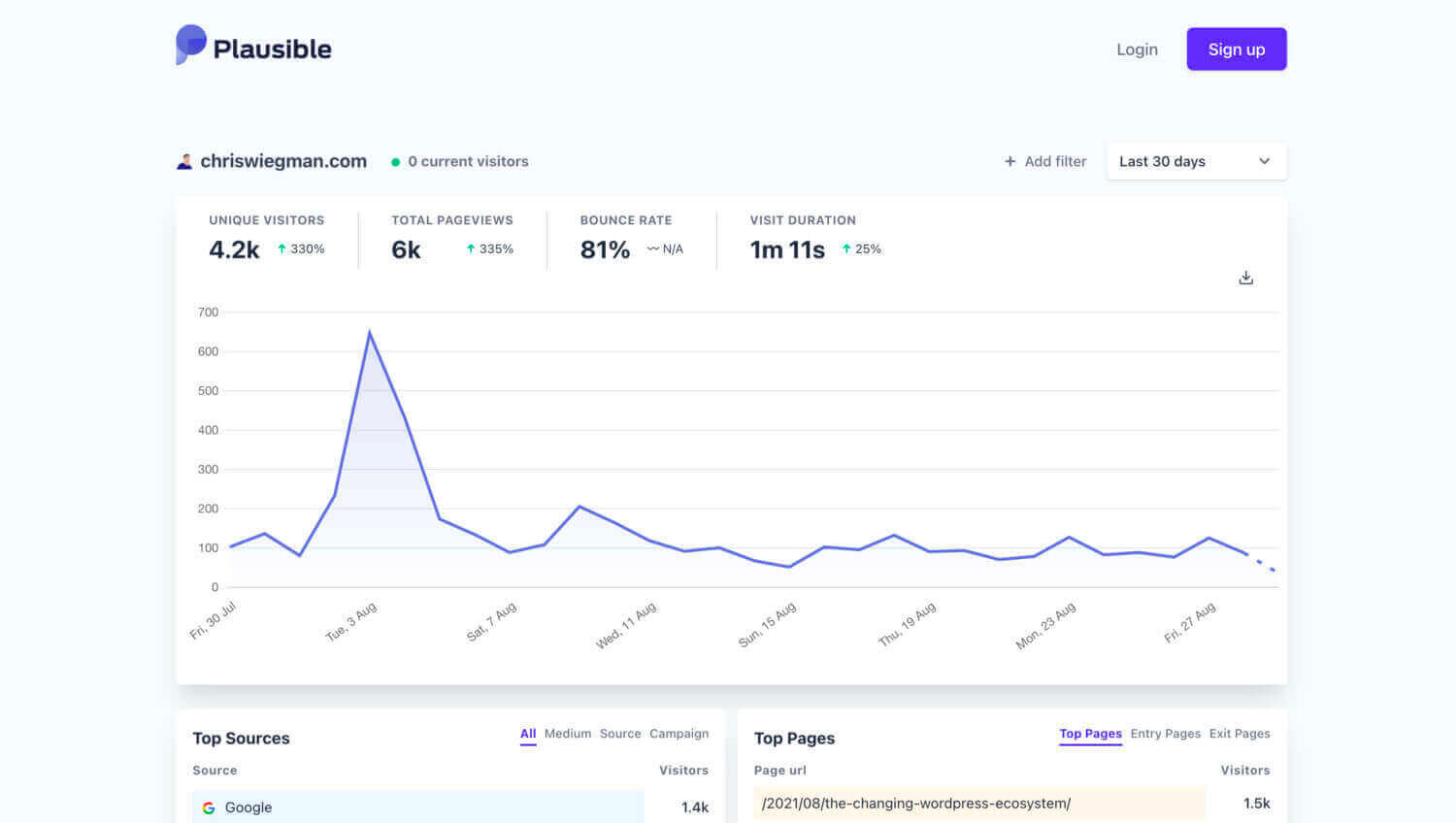
When I re-launched this site in July I added a number of new features including analytics. Over the years I’ve tried a number of solutions for keeping track of site visitors including Google Analytics, JetPack Analytics, GoAccess and even no analytics at all. As of July, however, I’m using Plausible Analytics to keep track of site visitors and, while it’s not perfect, I’m really happy with it so far. Here’s a breakdown of what works for me and what I think could be improved.
Why analytics?
Before I get too deep into the pros and cons of Plausible I want to address why I went back to using analytics at all.
For about two years I had no analytics at all on this site. I didn’t know who was visiting, where they were finding content or what content was valuable to anyone. If this was solely a site with personal content that might be OK but, at least for me, I found that I completely lost the reason I was writing in the first place.
Analytics don’t have to be a privacy-invasive evil. If done right analytics can help demonstrate various metrics of success and worth as well as give valuable insights into what your audience wants to hear. I missed those insights but I couldn’t justify solving them with such an invasive solution like Google Analytics. Instead I’ve gone with Plausible Analytics.
Pros
Plausible bills itself as a privacy-friendly alternative to Google Analytics. It is a relatively new product built by a small team and has focused on the fundamentals of who is visiting your site, where they’re going and how they got there.
As a result they offer a clean and transparent dashboard which I was able to setup on My WordPress site within a few minutes. There were no obscure codes to configure or files to edit, all I had to do was activate their plugin and connect it to my account. With such a clean and simple interface this was easier to do than any of the solutions I used in the past.
Once setup, Plausible Analytics has been completely hands off. I can now see what is going on with my site both in my WordPress Dashboard or by visiting my analytics page directly which, for the sake of transparency, is completely open for anyone to link to from this site’s footer.
The analytics themselves offer all the basics of visitor counts, trends, basic identifiers and locations and makes it all really easy to find. There’s a reason many tech training sites have full courses for Google Analytics today. You won’t need that with Plausible. All your basics are there without any fuss in a format that is perfect for both new and experienced site owners.
Beyond the simple install and clean interface is their commitment to privacy. Not a lot of analytics services seem to even try in this regard. As you can see in their privacy policy, they don’t use cookies, they don’t collect personal information and the information they collect is not used for advertising. Instead they collect what is needed to give a site owner the insights they need to make their site better. This is what ethical data looks like.
Cons
While I love Plausible I do feel it’s also right for me to list the few issues I’ve had with it.
First, it isn’t free. While I don’t consider that a problem for my own use, it does make the service a hard sell, particularly to folks with a new site or other type of site that doesn’t make them enough money to cover the modest fee.
The other issue I have is that getting data about an individual post or page is not as easy as it could be. You can drill down to an individual url within your stats page but there is no way, at least in the WordPress Dashboard, to link directly to the stats for any individual page. In this case a few extra links in their WordPress plugin would make all the difference in the work for usability.
The TL;DR
Pros
- Easy to setup
- Excellent, simple site stats
- Private
- Clean interface
- Reasonable price
Cons
- It’s not free
- WordPress integration could be deeper
In the end, Plausible is a private, ethical alternative to Google Analytics that will tell you what you need to know about your visitors with a bare minimum of effort. While it isn’t free, the team behind it has been responsive to issues and concerns and is more than deserving of the support needed to make Plausible a successful and sustainable alternative that is safe for you and your users.
 Chris Wiegman
Chris Wiegman